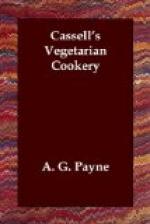We think these few preliminary observations necessary as we have to overcome a very strong English prejudice, which is too apt to despise everything of which the remark can be made—“Ah! but there is very little nourishment in it.” Vegetarian soups, as a rule, and especially the thin ones, must be regarded as a light and pleasant flavouring which, with a small piece of white bread enables the most obstinately delicate stomach to commence a repast that experience has found best adapted to its requirements.
The basis of all soup is stock, and in making stock we, of course, have to depend upon vegetables, fruit, or some kind of farinaceous food. To a certain extent the water in which any kind of vegetable has been boiled may be regarded as stock, especially water that has boiled roots, such as potatoes; or grains, such as rice. It will not, however, be necessary to enter into any general description as to the best method of obtaining nutriment in a liquid form from vegetables and grain, as directions will be given in each recipe, but a few words are necessary on the general subject of flavouring stock. In making ordinary soup we are very much dependent for flavour, if the soup be good, on the meat, the vegetables acting only as accessories. In making stock for vegetarian soups we are chiefly dependent for flavour on the vegetables themselves, and consequently great care must be taken that these flavourings are properly blended. The great difficulty in giving directions in cookery-books, and in understanding them when given, is the insuperable one of avoiding vague expressions. For instance, suppose we read, “Take two onions, one carrot, one turnip, and one head of celery,”—what does this mean? It will be found practically that these directions vary considerably according to the neighbourhood or part of the country in which we live. For instance, so much depends upon where we take our head of celery from. Suppose we bought our head of celery in Bond Street or the Central Arcade in Covent Garden Market on the one hand, or off a barrow in the Mile End Road on the other. Again, onions vary so much in size that we cannot draw any hard-and-fast line between a little pickling onion no bigger than a marble and a Spanish onion as big as a baby’s head. It would be possible to be very precise and say, “Take so many ounces of celery, or so many pounds of carrot, but practically we cannot turn the kitchen into a chemist’s shop. Cooks, whether told to use celery in heads or ounces, would act on guess-work just the same. What are absolutely essential are two things—common sense and experience.
Again, practically, we must avoid giving too many ingredients. Novices in the art of cooking are, of course, unable to distinguish between those vegetables that are absolutely essential and those added to give a slight extra flavour, but which make very little difference to the soup whether they are added or not. We are often directed to add a few leaves of tarragon, or chervil, or a handful of sorrel. Of course, in a large kitchen, presided over by a Francatelli, these are easily obtainable; but in ordinary private houses, and in most parts of the country, they are not only unobtainable but have never even been heard of at the greengrocer’s shop.




